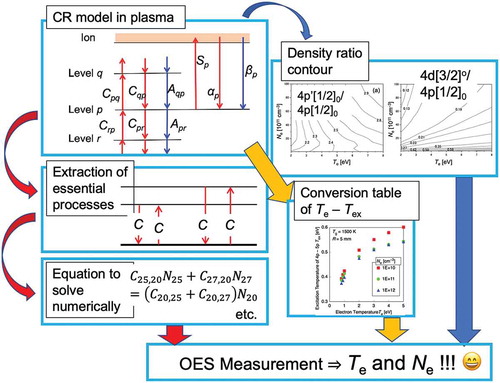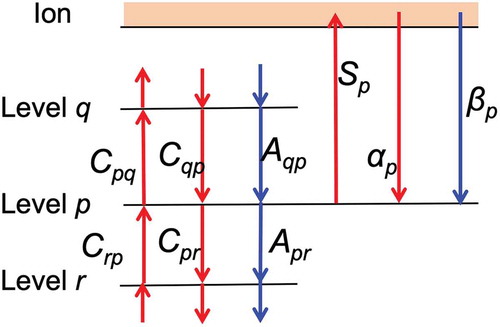Figures & data

Figure 1. Schematic diagram of excitation kinetics of the level p in the collisional-radiative (CR) model. Red arrows indicate electron collisional processes, while the blue arrows indicate radiative processes. Characters in the figure correspond to their rate coefficients in Equation (1).

Figure 2. Schematic diagram of the ‘phases’ of the hydrogen-like ionizing plasma; i.e. ‘Corona phase’, ‘Saturation (Thermodynamically Equilibrium: TE) phase’ and ‘Saturation (Ladder-like) phase’. p is the principal quantum number, N/g is the reduced population density. The straight arrow indicates electron collision excitation/deexcitation process, while the wavy arrow indicates radiative process. Horizontal axis denotes the logarithm of reduced electron density divided by z 7. The phase transition lines ‘GRIEM’ and ‘BYRON’ indicate the Griem’s boundary (Equation (5)) and the Byron’s boundary (Equation (6)), respectively [Citation33,Citation37].
![Figure 2. Schematic diagram of the ‘phases’ of the hydrogen-like ionizing plasma; i.e. ‘Corona phase’, ‘Saturation (Thermodynamically Equilibrium: TE) phase’ and ‘Saturation (Ladder-like) phase’. p is the principal quantum number, N/g is the reduced population density. The straight arrow indicates electron collision excitation/deexcitation process, while the wavy arrow indicates radiative process. Horizontal axis denotes the logarithm of reduced electron density divided by z 7. The phase transition lines ‘GRIEM’ and ‘BYRON’ indicate the Griem’s boundary (Equation (5)) and the Byron’s boundary (Equation (6)), respectively [Citation33,Citation37].](/cms/asset/0978a495-b3bf-4269-9f7b-49859ca855da/tapx_a_1592707_f0002_b.gif)
Figure 3. Essential elementary processes for the population and depopulation of the level N = 20 (4d + 6s) for the electron temperature range (a) 0.8 ≤ Te [eV] ≤ 1.2 and (b) 1.2 ≤ Te [eV] ≤ 2.0. The symbol C denotes the electron collision process. It is found that C23,30N23C20,23N20 under the condition (a), and consequently, the equation to be solved can be simplified.
![Figure 3. Essential elementary processes for the population and depopulation of the level N = 20 (4d + 6s) for the electron temperature range (a) 0.8 ≤ Te [eV] ≤ 1.2 and (b) 1.2 ≤ Te [eV] ≤ 2.0. The symbol C denotes the electron collision process. It is found that C23,30N23≃C20,23N20 under the condition (a), and consequently, the equation to be solved can be simplified.](/cms/asset/8bada284-c751-425c-adf4-1f3e30f30961/tapx_a_1592707_f0003_oc.jpg)
Figure 4. Comparison of the electron temperature measured with the Langmuir probe and that with the OES method assisted with the CR model described by Equations (11) – (14) as schematically shown in for the hollow cathode DC discharge argon plasma for its discharge current 6 A [Citation72].
![Figure 4. Comparison of the electron temperature measured with the Langmuir probe and that with the OES method assisted with the CR model described by Equations (11) – (14) as schematically shown in Figure 3 for the hollow cathode DC discharge argon plasma for its discharge current 6 A [Citation72].](/cms/asset/667142fa-62a9-4bee-91bb-6fc88fc1ffc2/tapx_a_1592707_f0004_b.gif)
Figure 5. Density contour of number density ratio of the excited states calculated with the argon CR model, displayed on Te-Ne map. (a) 4p’ [1/2]0/4p[1/2]0, and (b) 4d[3/2]°/4p[1/2]0 [Citation44].
![Figure 5. Density contour of number density ratio of the excited states calculated with the argon CR model, displayed on Te-Ne map. (a) 4p’ [1/2]0/4p[1/2]0, and (b) 4d[3/2]°/4p[1/2]0 [Citation44].](/cms/asset/ff491686-381b-48f7-a942-532035637fbd/tapx_a_1592707_f0005_b.gif)
Figure 6. Electron temperature and density measured for the argon plasma generated in the small helicon device (SHD) developed for the electric propulsion of satellite maneuver [Citation81–Citation83]. Red open squares are those measured with the scheme described in section 3.2, with two intensity ratios of (687.1 nm)/(763.5 nm) [= 4d[1/2]°/4p[3/2] = 4d5/2p6] and (549.6 nm)/(751.5 nm) [= 6d[7/2]°/4p[1/2]0 = 6d’4/2p5] with most revised cross section data in Ref [Citation78]., while green open diamonds are the same but with the old cross section data in Ref [Citation40]. Blue filled dots are those measured with a Langmuir single probe.
![Figure 6. Electron temperature and density measured for the argon plasma generated in the small helicon device (SHD) developed for the electric propulsion of satellite maneuver [Citation81–Citation83]. Red open squares are those measured with the scheme described in section 3.2, with two intensity ratios of (687.1 nm)/(763.5 nm) [= 4d[1/2]°/4p[3/2] = 4d5/2p6] and (549.6 nm)/(751.5 nm) [= 6d[7/2]°/4p[1/2]0 = 6d’4/2p5] with most revised cross section data in Ref [Citation78]., while green open diamonds are the same but with the old cross section data in Ref [Citation40]. Blue filled dots are those measured with a Langmuir single probe.](/cms/asset/5092fb45-2e1c-4029-9787-21334a922dc6/tapx_a_1592707_f0006_oc.jpg)
Figure 7. Reduced number densities N/g of the levels 4p, 4p’, 5p and 5p’, calculated with the argon CR model normalized by that of the 4p[1/2]1 level. Linear fitting in the figure gives the excitation temperature with its slope. When the fitting is conducted, the statistical weight is reflected for the regression calculation.
![Figure 7. Reduced number densities N/g of the levels 4p, 4p’, 5p and 5p’, calculated with the argon CR model normalized by that of the 4p[1/2]1 level. Linear fitting in the figure gives the excitation temperature with its slope. When the fitting is conducted, the statistical weight is reflected for the regression calculation.](/cms/asset/7e633c48-6f4e-4b4c-aaea-831fcc3ff610/tapx_a_1592707_f0007_oc.jpg)
Figure 8. The relationship between the electron temperature Te and the excitation temperature Tex determined for 4p – 5p levels calculated with the argon CR model. It is assumed that the gas temperature Tg = 1500 K and the discharge tube radius R = 5 mm, with the electron density Ne = 1010–1012 cm–3 [Citation87,Citation88].
![Figure 8. The relationship between the electron temperature Te and the excitation temperature Tex determined for 4p – 5p levels calculated with the argon CR model. It is assumed that the gas temperature Tg = 1500 K and the discharge tube radius R = 5 mm, with the electron density Ne = 1010–1012 cm–3 [Citation87,Citation88].](/cms/asset/57205425-a324-44ca-ab97-1bc18f3aece6/tapx_a_1592707_f0008_oc.jpg)
